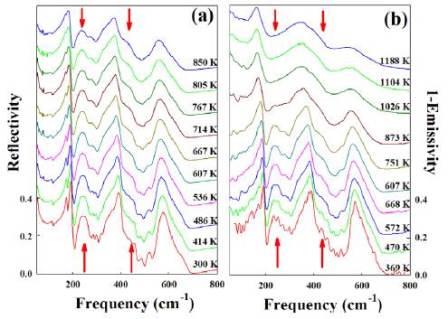Ask for a reprint
email :
* Give your email
2013
ACL
|
N.E.Massa, L.del Campo, D.De Sousa Meneses, P.Echegut, M.J.Martınez-Lope, J.A.Alonso, 'High temperature far-infrared dynamics of orthorhombic NdMnO3: emissivity and reflectivity', J. Phys. Cond. Mat. 25 235603 (2013) doi:10.1088/0953-8984/25/23/235603
We report on near normal far- and mid-infrared emission and reflectivity of NdMnO3 perovskite from room temperature to sample decomposition above 1800 K. At 300 K the number of infrared active phonons is in close agreement with the 25 calculated for the orthorhombic D16 2h–Pbnm (Z D 4) space group. Their number gradually decreases as we approach the temperature of orbital disorder at �1023 K where the orthorhombic O0 lower temperature cooperative phase coexists with the cubic orthorhombic O. At above �1200 K, the three infrared active phonons coincide with that expected for cubic Pm-3m (Z D 1) in the high temperature insulating regime. Heating samples in dry air triggers double exchange conductivity by Mn3C and Mn4C ions and a small polaron mid-infrared band. Fits to the optical conductivity single out the octahedral antisymmetric and symmetric vibrational modes as the main phonons in the electron–phonon interactions at 875 K. For 1745 K, it is enough to consider the symmetric stretching internal mode. An overdamped defect induced Drude component is clearly outlined at the highest temperatures. We conclude that rare earth manganite eg electrons are prone to spin, charge, orbital, and lattice couplings in an intrinsic orbital distorted perovskite lattice, favoring embryonic low energy collective excitations.
|

|